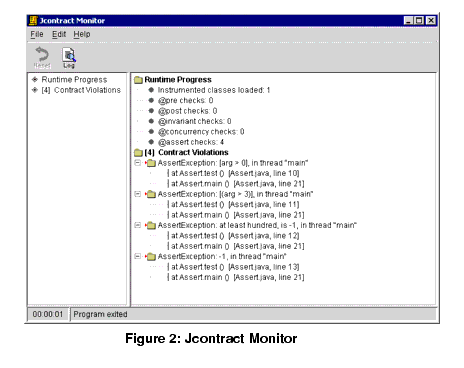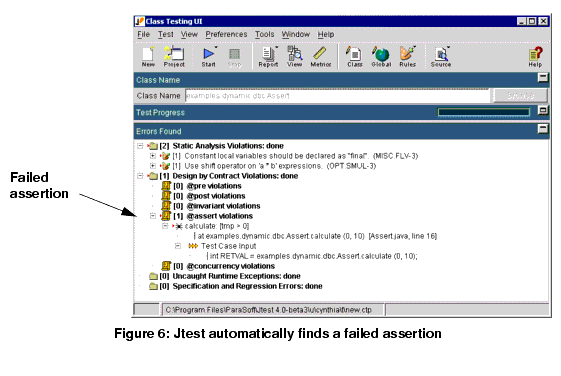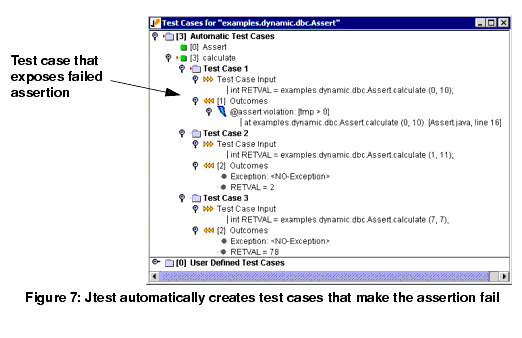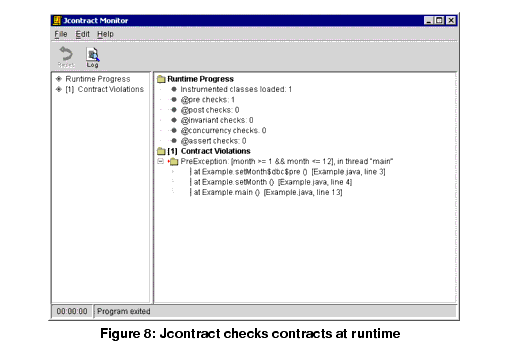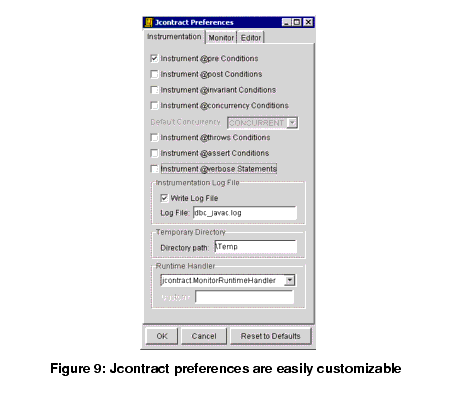
ParaSoft
HOME Jtest
Quick Facts |
|
For a Printable Version, Click Here. Using Design by ContractTM to Automate JavaTM Software and Component TestingTable of Contents
AbstractDesign by Contract (DbC) is a beneficial software development practice that, until now, was too cumbersome to actually incorporate into most development processes. Jtest and Jcontract make it possible for you to realistically implement DbC. Jtest helps you add specification information into your code using DbC contracts. This is beneficial because it ensures that the code and specification are always kept together. From the DbC contracts, Jtest automatically creates test cases that verify class/component functionality. Because this relieves you from having to create black-box test cases, you save a tremendous amount of time and resources. When the classes/components that contain DbC contracts are added to the system, Jcontract automatically verifies whether the system uses them correctly. A misused class/component might appear to perform fine, but might actually spur subtle errors that can trigger system-wide problems. 1. IntroductionDesign by ContractTM (DbC) is a formal way of using comments to incorporate specification information into the code itself. Basically, the code specification is expressed unambiguously using a formal language that describes the code's implicit contracts. These contracts specify such requirements as:
On its own, DbC can be an effective way to prevent errors throughout the development process. It can be even more powerful when used with ParaSoft's Jtest® and JcontractTM, two JavaTM development tools that understand and take full advantage of the specification information recorded in the DbC contracts. Jtest is a Java unit testing tool that tests any Java class or component; it completely automates black-box testing (functionality testing), white-box testing (construction testing), and regression testing, as well as static analysis. For more information on Jtest's general features, see our paper "Automatic Java Software and Component Testing: Using Jtest to Automate Unit Testing and Coding Standard Enforcement". Jtest has been extended to work with the DbC language: when used with classes or components that contain DbC contracts, Jtest automates black-box testing, a process that few people ever thought could be automated. Jtest reads the specification information built into a class, then automatically creates and executes test cases that check the functionality described in the specification. It also tailors its unit-level white-box test creation to the specifications contained in the contract. Jcontract is a new Java development tool that checks DbC contracts at runtime; it can be run independently of Jtest, but the two tools are complementary. After you have used Jtest to thoroughly test your class or component at the unit level, use Jcontract to instrument and compile the DbC-commented code. Once a class or component is instrumented, Jcontract automatically checks whether its contracts are violated at runtime. Jcontract is particularly useful for determining whether an application misuses specific classes or components. Together, these tools will help you improve the quality and speed of unit-level and system-level testing. This paper will introduce you to the DbC language, briefly explain how Jtest and Jcontract can leverage DbC information, then describe in detail how using DbC along with these tools can improve your development process. 1.1 About Design by ContractDbC originated in Eiffel. Eiffel classes are components that cooperate through the use of the contract, which defines the obligations and benefits for each class. For an excellent introduction to DbC and a description of how it can be applied to Eiffel, see "Building bug-free O-O software: An introduction to Design by ContractTM" at http://www.eiffel.com/doc/manuals/technology/contract/page.html
DbC is not yet commonly a part of programming languages such as C, C++, and Java, but ideally it should be. After all, any piece of code in any language has implicit contracts attached to it. The simplest example of an implicit contract is a method to which you are not supposed to pass Applying DbC to your code has significant benefits even before you start using Jtest and Jcontract. These benefits include:
Once you start using Jtest and Jcontract, the benefits of using DbC also include:
How difficult is it to use the DbC language in Java development? Not very. There have been several efforts to make DbC available in Java. Most of the efforts involve using public class ShoppingCart { /** * @pre item != null * @post $result > 0 */ public float add (Item item) { _items.addElement (item); _totalCost += item.getPrice (); return _totalCost; } private float _totalCost = 0; private Vector _items = new Vector (); } The contract contains the following conditions:
Preconditions and postconditions can be thought of as sophisticated assertions. Preconditions are conditions that the method's client needs to satisfy before the method can execute; a violation of a precondition indicates a problem with the client (the client is misusing the method). Postconditions are conditions that the implementor of the class guarantees will always be satisfied after a method completes; a postcondition violation indicates a problem within the method. Other contract elements that Jtest and Jcontract understand and use include: For more information about DbC see:
1.2 About JtestJtest is a Java unit testing and static analysis tool; its general purpose is to help you ensure that any class or component is solid and correct before it is integrated into an application. Jtest's DbC-related functionality (just one part of Jtest's total functionality) helps you create a DbC contract, then automatically verifies if the class or component under test is built according to the specification incorporated into the contract. In other words, it completely automates the black-box (functionality) testing process. This DbC-specific functionality is described below. As you create code, you incorporate specification information into it using the DbC language. Next, you compile your class as normal, then tell Jtest to test it. With the click of a button, Jtest performs the following DbC-related tasks in addition to its normal white-box (construction) testing, black-box testing, regression testing, and static analysis tasks:
For a more detailed description of this functionality, see the "Unit Testing" section. Once all of the problems that Jtest uncovered (functionality problems, construction problems, and static analysis violations) are repaired, the class is ready to be integrated into the system. At that point, Jcontract can be used to monitor whether the class's contracts are met at runtime. 1.3 About JcontractJcontract is used to check a class or component's contracts at runtime, after you have used Jtest to verify that the class or component is solid and correct. It is complementary to Jtest, but the respective tools can be used independently of one another.
When you have thoroughly tested a class or component and are ready to integrate it into the system, recompile it with Jcontract by simply calling Jcontract's dbc_javac Example.java Jcontract then instruments the code's specification information and recompiles the class with extra bytecodes that describe how the class is supposed to work and be used. Next, integrate the instrumented class into the system, and run the system. Jcontract watches the system as it runs, and like an X-ray machine, automatically detects contract violations. For example, if a component's DbC specification said that a particular method required positive integer inputs, Jcontract would report a violation if the system passed that method any negative inputs. By default, contract violations found are reported in the Jcontract monitor. This monitor displays the nature of each violation as well as stack trace information. Jcontract's degree of program interference is completely customizable. By default, Jcontract uses a non-intrusive runtime handler that reports violations found, but does not alter program execution. You can also choose a runtime handler that throws an exception when a violation occurs, choose a runtime handler that logs violations in a file, or create a customized runtime handler that is specially tailored to your needs. Jcontract also adapts to your needs by letting you select which contract conditions you want it to instrument. This way, you can optimize program performance by having Jcontract focus on the conditions that are most important at your current stage of the development process. For example, after a well-tested class is integrated into an application, you might only want to instrument and check preconditions that verify whether the application uses the class correctly. For a more detailed description of Jcontract's functionality, see the "System-Level Testing" section. 2. Improving the Quality and Speed of TestingAt this point, we have given you a brief overview of the DbC language and how Jtest and Jcontract leverage the information provided in DbC-format contracts. The remainder of this paper is dedicated to describing in detail how Jtest and Jcontract use DbC information to make the entire testing phase faster and more efficient. 2.1 Unit TestingOften, developers hear about unit testing and think the term refers to module testing. In other words, developers think they are performing unit testing when they take a module, or a sub-program that is part of a larger application, and test it. Module testing is important and should certainly be performed, but it is not the technique that we want to concentrate on here. When we use the term "unit testing," we are talking about testing the smallest possible unit of an application; in terms of Java, unit testing involves testing a class as soon as it is compiled. Jtest automates all steps of the otherwise time-consuming unit testing process: it automatically creates a harness and any necessary stubs for the class under test, then performs white-box testing, black-box testing, regression testing, and static analysis. This section focuses on how Jtest uses DbC contracts in the unit testing process. 2.1.1 Adding Comments
Before your tools can use DbC information, someone needs to add the contract to the code. That's why Jtest uses static analysis to guide you through the process of adding DbC comments. When you let Jtest statically analyze the The coding standards that Jtest applies include:
For example, when Jtest finds a public method without an By automatically checking contracts as part of static analysis, Jtest makes it easier to implement DbC as a team-wide or company-wide coding standard. 2.1.2 Automating Unit-Level Black-Box (Functionality) TestingAs we said earlier, Jtest uses the DbC specification information to automatically create and execute test cases that verify whether a class or component functions as its DbC specification says it should function. When you test a class or component with Jtest, Jtest automatically creates and executes black-box test cases as part of its normal battery of tests. Jtest designs its black-box test cases as follows:
For example, the following code contains a postcondition that describes part of the method's specification: package examples.dynamic.dbc; class Post { /** @post $result == a + b */ public static int add (int a, int b) { return a - b; //BUG: note it should be '+' not '-' } }
According to the specification, the method should return When we test this class, Jtest instruments the comments, compiles the class, analyzes the specification information, then creates and executes test cases that check whether its functionality is implemented correctly
The test results reveal that the functionality is not implemented correctly. Jtest's Test Cases window displays selected test cases that were created automatically (only the test cases that do something new [e.g., increase coverage, throw a new exception, etc.] are shown). Test Case 1 shows that the method functions as specified when the value of For a second example, let's look at a class that has a simple assertion. package examples.dynamic.dbc; public class Assert { public static int calculate (int size1, int size2) { int tmp = size1 * size2 - 10; /** @assert tmp > 0 */ return tmp * 2; } }
When Jtest tests this class, it tries to create test cases that make the assertion fail. Once again, Jtest automatically creates test cases that test the specified functionality and expose functionality problems. After the code is repaired, these same test cases can be replayed to determine whether or not the modifications actually repaired the problem. 2.1.3 Optimizing Unit-Level White-Box (Construction) TestingDbC can also help you optimize your unit-level white-box (construction) testing with Jtest. You can use DbC comments to filter out error messages that are not relevant to the class under test.
If you document expected exceptions in the code using the
If you document the permissible range for valid method inputs using the 2.2 System-Level TestingSystem-level testing can uncover different types of errors than unit testing: it can expose instances where the system misuses a class or component as well as instances where complex system interactions cause problems that were not apparent at the unit-level.
After you are confident that your class or component works correctly, recompile it with Jcontract's
If performance speed is an issue, you can easily configure Jcontract so that it only instruments the contract types that you are most concerned with. This makes it easy for you to get the precise checking that you need without sacrificing performance. For example, say that you have thoroughly tested a performance-critical class at the unit level and are fairly certain that it functions correctly. You want to determine if it is used correctly within the system, but you do not want the performance hit that might arise from checking all of the class's postcondition and assertion contracts. Your best solution would be to have Jcontract instrument only the preconditions when it recompiled the class; this way, you would gain the precondition checking without a significant impact on that critical class's performance. 3. ConclusionDesign by Contract is a beneficial software development practice, but until now, the time required to implement it prevented the majority of developers from incorporating it into their development process. Jtest and Jcontract make it possible to realistically implement DbC and reap the benefits that DbC has to offer. When you use DbC along with Jtest and Jcontract:
With these tools, a small upfront investment in writing specifications (which should be written anyway) allows you to produce more reliable and reusable software in less time than ever before. 4. ReferencesInteractive Software Engineering, "Building Bug-Free O-O Software: An Introduction to Design by ContractTM." http://www.eiffel.com/doc/manuals/technology/contract/page.html Eldridge, G. "Java and `Design by Contract.' http://www.elj.com/eiffel/feature/dbc/java/ge/" Kolawa, A., "Automating the Development Process." Software Development, July 2000. http://www.sdmagazine.com ParaSoft Corporation, "Automatic Java Software and Component Testing: Using Jtest to Automate Unit Testing and Coding Standard Enforcement." 5. AvailabilityTo learn more about how Jtest, Jcontract, and other ParaSoft development tools can help your department prevent and detect errors, talk to a Software Quality Specialist today at 1-888-305-0041, or visit www.parasoft.com. 6. Contacting ParaSoftUSA
2031 S. Myrtle Ave. Europe
France: Tel: +33 1 64 89 26 00 ParaSoft and Jtest are registered trademarks of ParaSoft Corporation. Jcontract is a trademark of ParaSoft Corporation. All other brands are trademarks or registered trademarks of their respective holders. |

| (888) 305-0041 info@parasoft.com Copyright © 1996-2001 ParaSoft |

